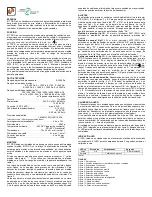
7
English
4 Setting into Operation
4.1 Inserting the batteries
For operating the pocket transmitter, two 1 .5 V batteries
of size AA are required .
•
Always insert (rechargeable) batteries of the same type
and always replace all of them .
•
If the pocket transmitter is not in use for a longer period
of time, always remove the batteries to prevent damage
due to battery leakage .
Never put batteries in the household waste .
Always dispose of the batteries in accordance
with local regulations .
To open the battery compartment (9), press the arrow of
the battery compartment cover (5) and push the cover
downwards . Insert the batteries with the positive and neg-
ative poles as indicated in fig . 2, then replace the cover .
4.2 Switching on the transmitter
Information on the display
To switch on the transmitter, set the switch (2) to ON .
(In the mid-position STDBY the transmitter is on, but the
microphone signal is muted .) The backlight of the dis-
play (3) is activated for a few seconds . The display shows
the following information:
1 . the channel group (GROUP 00 – 07)
2 . the channel (CHANNEL 00 – 99)
3 . the battery status
BATT
■
■
■
■
■
BATT
■
■
■
BATT
full half-full discharged
Replace the batteries when the indication BATT starts flashing .
Make the settings described in the chapters below .
Remember to switch off the transmitter after use to
prevent discharge of the batteries .
4.3 Setting the transmission channel
1) First set a free transmission channel on the receiver
(see instruction manual of the receiver) .
2) Point the IR sensor (4) of the transmitter towards the IR
window of the receiver . The distance must not exceed
1 .5 m . Make sure that there are no obstacles between
the sensor and the IR window .
3) Briefly press the button ACT on the receiver . The display
backlight of the pocket transmitter is activated . Thus,
the transmitter and the receiver are set to the same
channel group and to the same channel (see indication
on the display) . The frequencies assigned to the chan-
nels can be found in the table on pages 16 /17 .
4.4 Connecting the microphone and attaching
the pocket transmitter
The TXS-606HSE / 2 allows to operate the following
electret microphones which feature a 3-pole mini XLR
connector:
Tie clip microphones
of the ECM-…L series
Headband microphones of the HSE-… series
Earband microphones of the HSE-… series
1) Connect the microphone to the XLR jack (6) of the
transmitter .
2) After setting the gain of the microphone signal (chap-
ter 4 .5), use the clip (7) to attach the transmitter to
your clothes (e . g . belt or waistband) .
4.5 Setting the gain of the microphone signal
1) Switch on the audio unit (e . g . mixer, amplifier) con-
nected to the receiver . Speak / sing into the microphone
and set the audio system to such a volume that the
subsequent setting can be heard well .
2) Set the gain of the microphone signal with the control
GAIN (8) on the rear side: If the volume of the micro-
phone signal is too high or if the signal is distorted,
turn back the control with a small screwdriver . If the
volume of the signal is too low, however, a poor sig-
nal-to-noise ratio results . In this case, advance the
control accordingly .
5 Specifications
Carrier frequencies: . . . . . . . 672 .000 – 691 .975 MHz
for channels see table on
pages 16 /17
Frequency stability: . . . . . . . ±0 .005 %
Transmission power (EIRP): . 10 mW
Audio frequency range: . . . 30 – 18 000 Hz, ±3 dB
Supply voltage
for the microphone: . . . . . . 5 V (
⎓
)
Power supply: . . . . . . . . . . 2 × 1 .5 V battery, size AA
Operating time: . . . . . . . . . > 8 h
Ambient temperature: . . . . 0 – 40 °C
Dimensions, weight: . . . . . . 61 × 106 × 27 mm, 80 g
Subject to technical modification .
All rights reserved by MONACOR
®
INTERNATIONAL GmbH & Co. KG.
No part of this instruction manual may be reproduced in any form or
by any means for any commercial use.




































